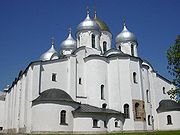
Vladimir of Novgorod
Encyclopedia

Veliky Novgorod
Veliky Novgorod is one of Russia's most historic cities and the administrative center of Novgorod Oblast. It is situated on the M10 federal highway connecting Moscow and St. Petersburg. The city lies along the Volkhov River just below its outflow from Lake Ilmen...
from 1036 until his death. He was the eldest son of Yaroslav I the Wise
Yaroslav I the Wise
Yaroslav I, Grand Prince of Rus, known as Yaroslav the Wise Yaroslav I, Grand Prince of Rus, known as Yaroslav the Wise Yaroslav I, Grand Prince of Rus, known as Yaroslav the Wise (Old Norse: Jarizleifr; ; Old East Slavic and Russian: Ярослав Мудрый; Ukrainian: Ярослав Мудрий; c...
of Kiev
Kiev
Kiev or Kyiv is the capital and the largest city of Ukraine, located in the north central part of the country on the Dnieper River. The population as of the 2001 census was 2,611,300. However, higher numbers have been cited in the press....
by Ingigerd, daughter of king Olof Skötkonung of Sweden
Sweden
Sweden , officially the Kingdom of Sweden , is a Nordic country on the Scandinavian Peninsula in Northern Europe. Sweden borders with Norway and Finland and is connected to Denmark by a bridge-tunnel across the Öresund....
.
In the state affairs he was assisted by the voivode Vyshata
Vyshata
Vyshata was a Novgorodian general and voivode, whose father is supposed to have been posadnik Ostromir and whose son was another statesman, Yan Vyshatich...
and the bishop
Archbishop of Novgorod
The Archbishop of Novgorod is the head of the eparchy of Novgorod the Great and is one of the oldest offices in the Russian Orthodox Church. The archbishops have, in fact, been among the most important figures in medieval Russian history and culture and their successors continued to play...
Luka Zhidiata
Luka Zhidiata
Luka Zhidiata was the second bishop of Novgorod the Great . He replaced Efrem, who was not consecrated bishop, but who administered the eparchy from the death of Ioakim Korsunianin until Luka's appointment....
. In 1042, Vladimir may have been in conflict with Finns, according to some interpretations even making a military campaign in Finland. In the next year he led the Russian armies together with Harald III of Norway against the Byzantine emperor
Rus'-Byzantine War (1043)
The final Rus'–Byzantine War was, in essence, an ,unsuccessful naval raid against Constantinople instigated by Yaroslav I of Kiev and led by his eldest son, Vladimir of Novgorod, in 1043.The reasons for the war are disputed, as is its course...
Constantine IX. He predeceased his father by two years and was buried by him in St Sophia Cathedral
Saint Sophia Cathedral in Novgorod
The Cathedral of St. Sophia in the Kremlin in Veliky Novgorod is the cathedral church of the Archbishop of Novgorod and the mother church of the Novgorodian Eparchy.-History:...
he had built in Novgorod. His sarcophagus is in a niche on the south side of the main body of the cathedral overlooking the Martirievskii Porch. He is depicted in an early twentieth century fresco above the sarcophagus and on a new ephigial icon on top of the sarcophagus. The details of his death is unknown, however his son Rostislav and his descendants were in unfriendly relationship with the descendants of the Yaroslaviches triumvirate (Iziaslav, Sviatoslav, and Vsevolod). Three of Vladimir's younger brothers Izyaslav I, Svyatoslav II and Vsevolod I all reigned in Kiev, while other two (Igor and Vyacheslav) died in their early twenties after which their lands were split between the Yaroslaviches triumvirate. Coincidentally, the Vyshata of Novgorod pledged his support to Rostislav in the struggle against the triumvirate.
Vladimir's only son, Rostislav Vladimirovich, was a landless prince who usurped power in Tmutarakan
Tmutarakan
Tmutarakan was a Mediaeval Russian principality and trading town that controlled the Cimmerian Bosporus, the passage from the Black Sea to the Sea of Azov. Its site was the ancient Greek colony of Hermonassa . It was situated on the Taman peninsula, in the present-day Krasnodar Krai of Russia,...
. His descendants were dispossessed by their uncles and were proclaimed as izgoi
Izgoi
Izgoi is a term found in medieval Kievan Rus'. In primary documents, it is used to indicate orphans protected by the church. In historiographic writing on the period, it meant a prince in Kievan Rus' who was excluded from succession to the Kievan throne because his father had not held the throne...
(outcast), but gradually managed to establish themselves in Halychyna, ruling the land until 1199, when their line went extinct. In order to downplay their claims to Kiev, the records of Vladimir's military campaigns seem to have been obliterated from Kievan chronicles. As a result, medieval historians often confuse him with two more famous namesakes — Vladimir the Great and Vladimir Monomakh. The name of Vladimir's consort
Princess consort
Princess consort is a title or an informal designation normally given to the wife of a sovereign prince. Since a male sovereign ruler is generally titled as a king and not a prince, the title of princess consort is not widely used. More rarely, it may be given to the spouse of a king, if the more...
is uncertain either. According to Nikolai Baumgarten Vladimir was married to the daughter of count Loepold of Staden, Ode. Others (Aleksandr Nazarenko) disregard that assumption or claim a different person.
Vladimir's memory was better preserved in foreign sources. In Norse saga
Norse saga
The sagas are stories about ancient Scandinavian and Germanic history, about early Viking voyages, the battles that took place during the voyages, about migration to Iceland and of feuds between Icelandic families...
s he frequently figures as Valdemar Holti (that is, "the Nimble"). George Cedrenus noticed Vladimir's arrogance in dealing with the Byzantines.

